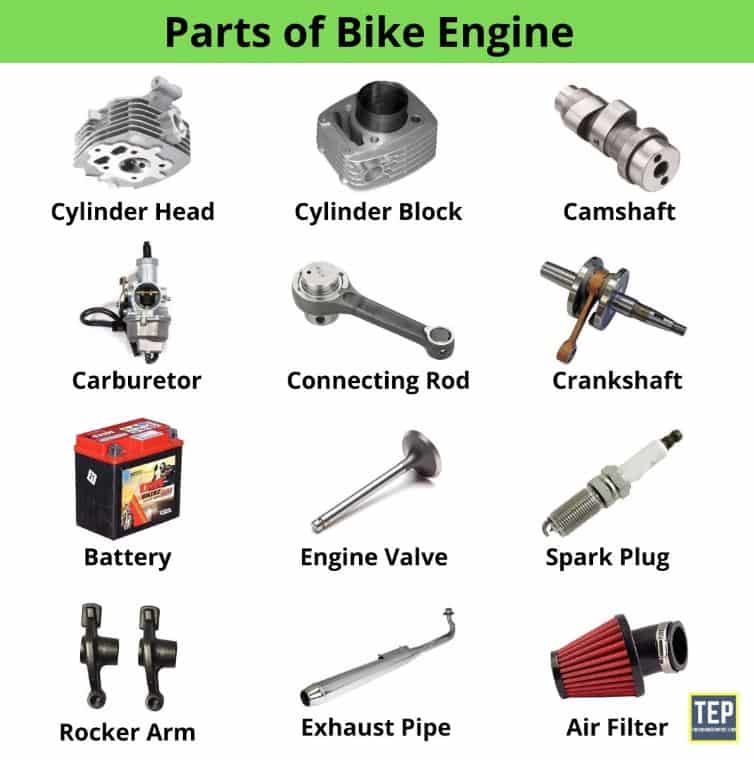
In this article, you will learn the different parts of bike engine and their functions. All explained with Names & Pictures.
If you need a PDF file, download it at the end of the article.
If you have ever ridden a motorcycle, you will understand how important it is to maintain your bike well for your safety on the road. When we talk about bikes, we talk about speed, robustness, smoothness, and stability.
Most people look for these specific trademarks before making any purchases for their motorcycles. However, only a few of us pay attention to the origin and source of this trademark: your motorcycle’s engine.
A bike engine is a type of engine that powers a bike. These engines are usually two-stroke or four-stroke internal combustion engines; some are liquid-cooled and air-cooled. This engine typically drives the rear wheel, with power sent to the wheel driven by a belt, chain, or shaft.
Furthermore, different parts inside a bike’s engine are responsible for different functions. Let’s understand the role of these bike engine parts.

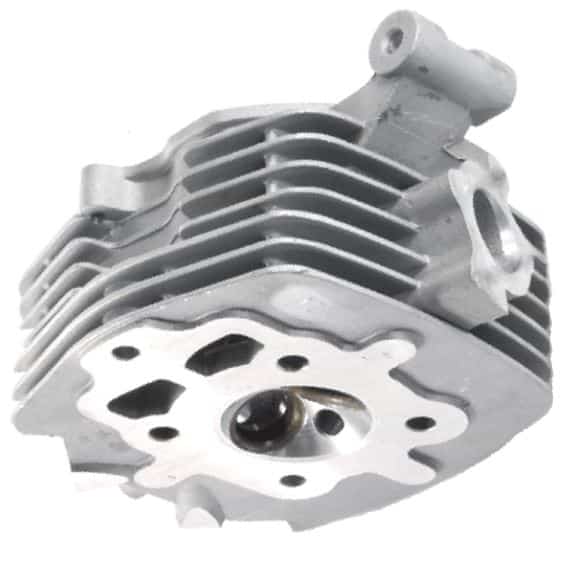
Image: Indiamart.com
The cylinder head is the part of an engine that is manufactured from various materials such as cast iron or aluminum alloy. They are essential for controlling airflow in and out of the cylinder and fuel deployment.
The function of the cylinder head is to cover the top of the engine cylinder and retain fuel in the engine cylinder itself. In addition, it helps to make fuel combustion safe and limited. It also includes the combustion chamber, shaft, and valve. Different motorbikes have different head sizes, affecting performance as some allow more space for combustion than others.
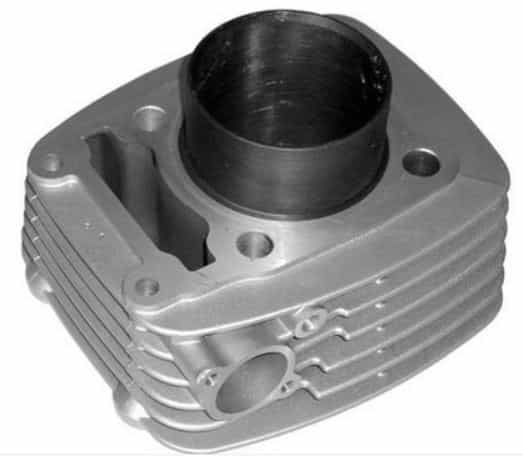
Cylinders play a vital role in all types of vehicles. Motorcycle engines can have up to six cylinders made of iron. It is capable of withstanding very high temperatures. The purpose of cylinders is to provide a sealed space for piston movement.
Typically, cylinders are known as engine blocks and are also used to measure engine power to determine cylinder size. A single-cylinder engine is one of the most straightforward combustion engines (simplest type).
Single cylinder engine: Running a single cylinder engine is cheap, and even the most amateur mechanic shouldn’t be taxed too much. They don’t have a lot of speed and not particularly good acceleration. Though they cool down much faster than other engines.
Twin cylinder engine: These are the most common motorbike engines in the UK. The twin cylinder engine is available in different variants, which include straight-twin, V-twin, flat-twin, and tandem-twin. The more cylinders a motorcycle has, the better the performance should be.
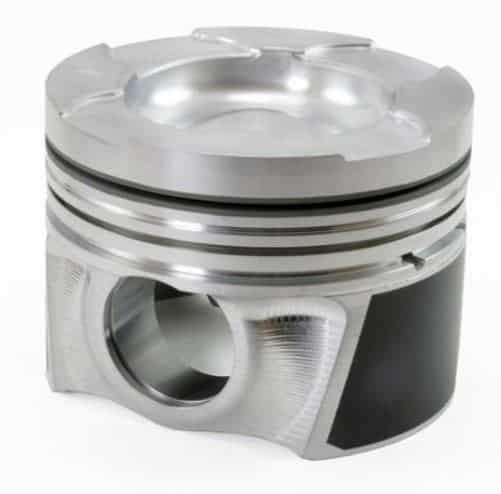
With the help of the piston, the connecting rod moves back and forth, moving up and down. A piston is a moving component contained in a cylinder and made gas-tight by piston rings.
The purpose of the piston is to transfer force from the expansion of gas in the cylinder through the connecting rod to the crankshaft. Pistons are commonly made of cast iron, aluminum or nickel, and steel alloys with cast iron. These pistons will move at a massive speed and must be in good condition as they can cause accidents if broken.
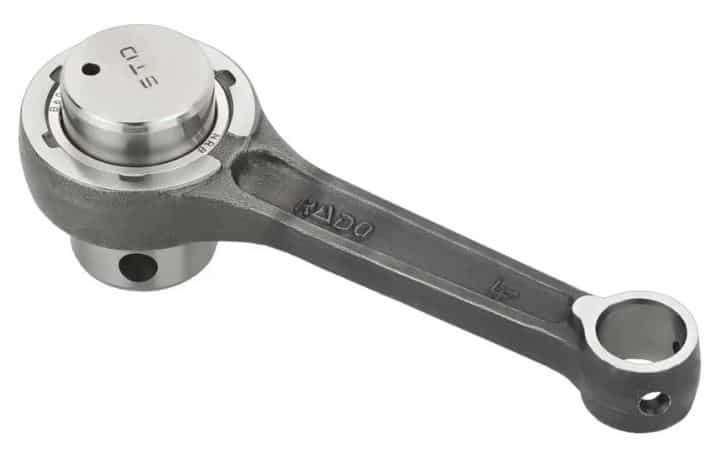
A connecting rod is the part of an engine that connects the piston to the crankshaft. The connecting rod converts the piston’s reciprocating motion into the crankshaft’s rotation with the crank. Generally, the connecting rod is made of aluminum or titanium.
The connecting rod is required to transmit compressive and tensile forces from the piston. If there is a problem with the connecting rod, it can cause several problems. Connecting rod problems can be challenging to diagnose. If any occurs then you’ll need to get professional mechanical advice.
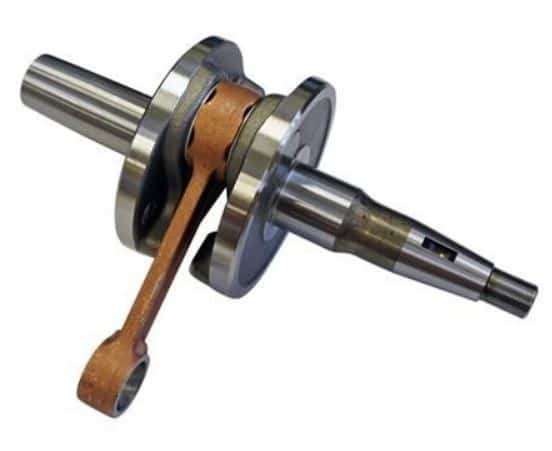
The crankshaft is also a vital part of an engine. It converts the reciprocating motion of the pistons into rotational motion. The rotary motion of the crankshaft sets the motorcycle chain and, eventually, the wheels of the motorcycle in motion.
It is observed that not all the pistons move simultaneously. Due to this, the different timing of the motion of the different pistons sets off a rhythmic movement throughout the system. This creates a particular demand for crankshafts. This is why each piston has a different and unique shape.
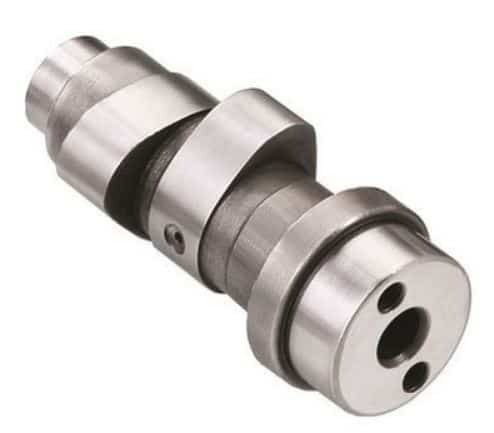
A camshaft is a rotating metal object with pointed cams, which converts rotational motion into reciprocating motion. Camshafts are used in IC engines to operate intake and exhaust valves, mechanically controlled ignition systems, and starting electric motor speed controllers.
The operation of engine valves depends on the camshaft and its lobes. They are supposed to control the valve opening and closing timing. These are typically made of steel or cast iron. It is an essential factor in determining the RPM range of an engine’s power band.
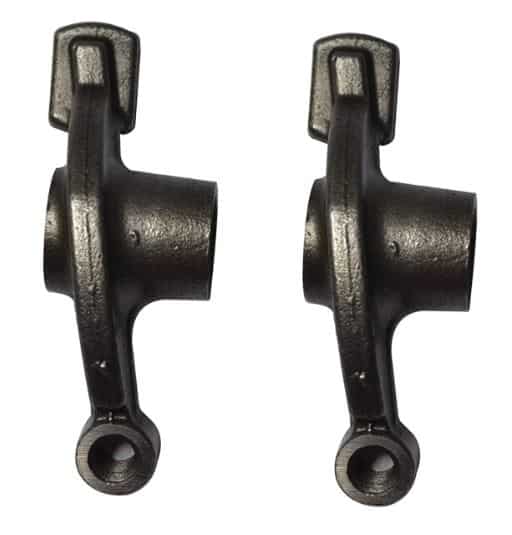
Image: Amazon.in
The rocker arm is responsible for transmitting camshaft movement to the intake and exhaust valves. The camshaft’s lobe guides one end of the rocker while the other pushes the spring-loaded valve to open.
The exhaust and intake valve may not function properly with a faulty rocker arm. Also, the cylinder attached to the faulty rocker arm will be disabled. This will eventually limit the performance of the engine and its ability to drive the bike smoothly and safely.
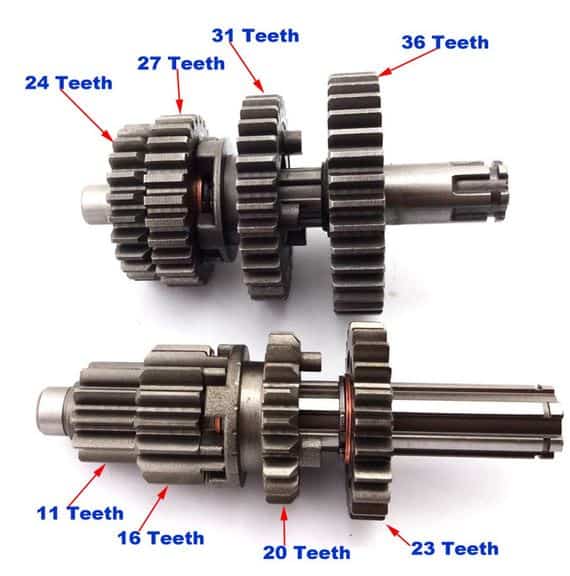
Image: wish.com
A bike engine can generate huge amounts of power transmitted to the wheels in a controlled manner. The motorcycle provides power to the rear wheel through transmission structures, including the gearset, clutch, and drive system.
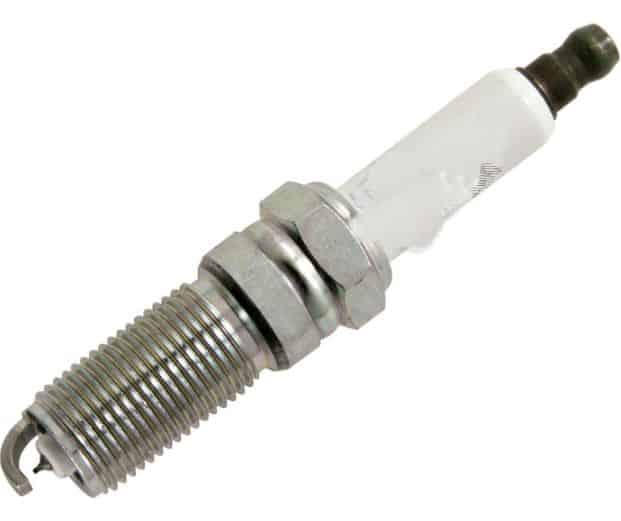
Spark plugs are one of the parts of your bike engine’s ignition system. Spark plugs produce a spark that raises the ignition temperature of the fuel-air mixture in the engine cylinders. Thus, the combustion engine converts chemical fuel energy into kinetic energy.
The spark plug receives an input of 12,000-25,000 volts from the high tension ignition coil. Timing for the spark must be precise, which is done by an electronic capacitor discharge ignition (CDI) unit. If the spark plug isn’t working, there may be a problem with the bike battery, as you need electricity to spark the spark plug and thus ignite the fuel.
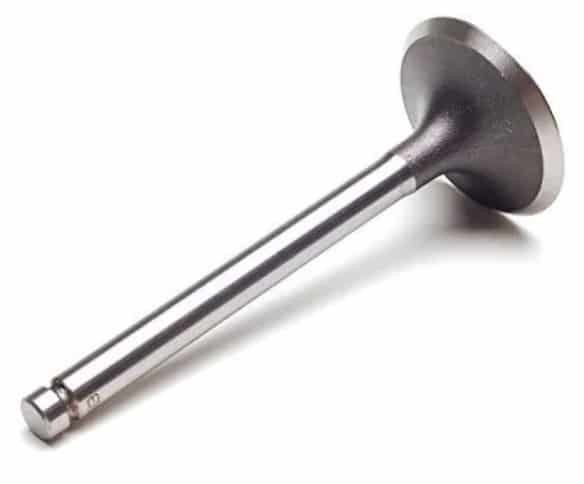
Engine valves are also essential parts of a bike engine as these valves control the passage of air and fuel in and out of the cylinder as air is vital for combustion. They also help in exhausting the smoke and fumes that are produced as a result of combustion.
You can also successfully monitor the combustion activity and efficiency of the cylinders if you keep your engine valves under control. In addition, you should also regularly adjust engine valves to avoid serious and costly problems.
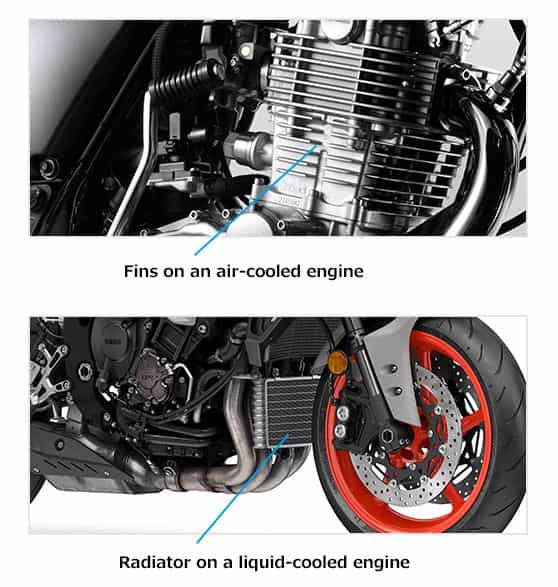
Image: global.yamaha-motor.com
Engines normally overheat while burning fuel to generate mechanical energy. This overheating will seize and damage engine internal components. The engine’s cooling system in the bike keeps it operating at its most efficient temperature.
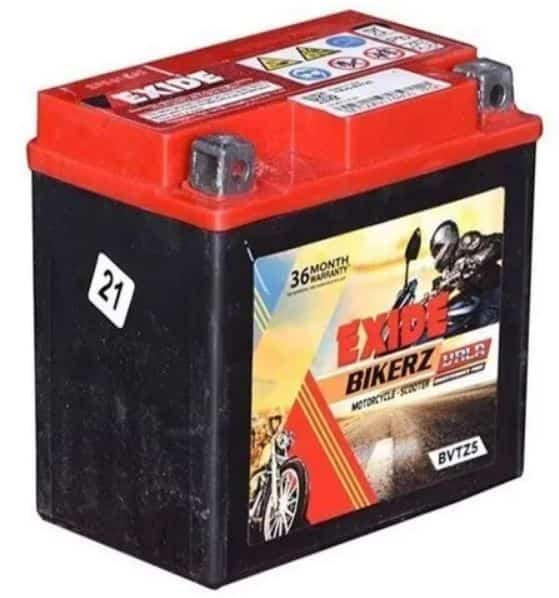
The battery is almost the central part of the functioning of the bike engine. The primary job of the battery is to power the bike and supply excess current when the alternator output is less.
It provides electrical energy to the ignition system, which converts chemical energy into mechanical energy. Apart from this, the battery also powers the headlights. Some motorcycles can start and run without a battery, especially smaller motorcycles that are 250 ccs or less and have a kick starter.
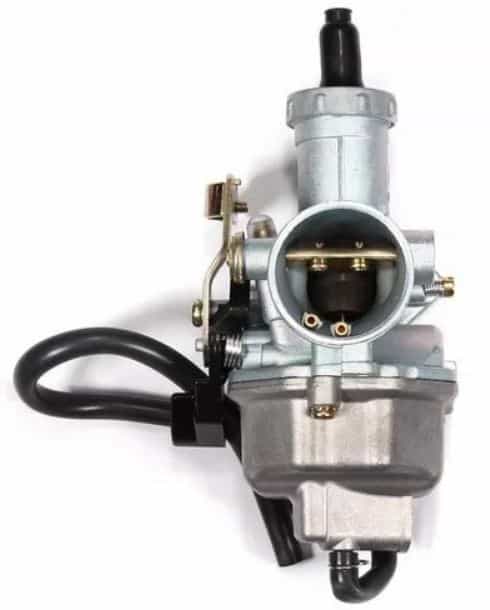
Carburetors have long been used to mix and pump air fuel into the inlet manifold at a specific ratio and volume. It controls the flow of air through its central bore (venturi). This flowing air draws in the fuel, and the mixture enters the engine through the intake valve.
Nowadays, motorcycles are fitted with a throttle body with injectors that use various sensors and electronic management systems to determine how much fuel is needed. The system is highly reliable and advanced, requiring very little maintenance.
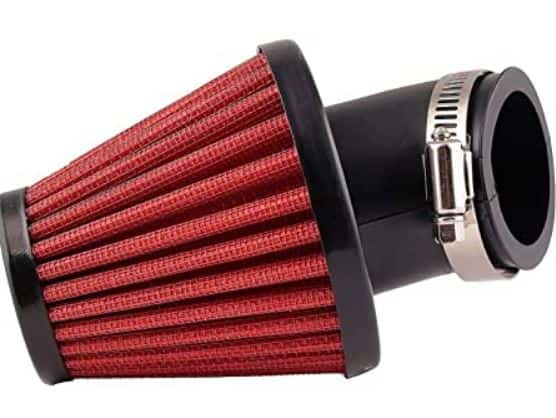
An air filter is installed in the carburetor or fuel injector. It ensures that contaminated air does not enter the engine. The purpose of an air filter is to protect the engine from dust and debris in the air and to improve airflow. It is also designed to increase acceleration and boost the motorcycle’s horsepower.
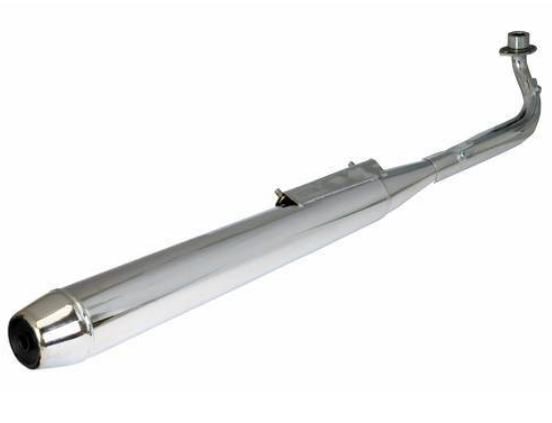
Burnt combustion gases have to be ejected, and their combustion results in a high decibel cacophony. This is where a silencer system is installed, which helps the engine to exhaust the gases faster and more efficiently.
So, for now, I hope I’ve covered everything about “Bike Engine Parts“. If you still think I missed anything or have any doubts on this topic, you can contact us or ask in the comments. If you like this article, then please share it with your buddies.
Want free PDFs direct to your inbox? Then subscribe to our newsletter.
Download PDF of this article: